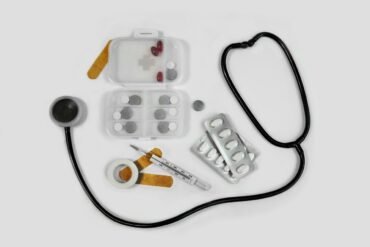Birth Control Options: Pills, Patches, and More

Table of Contents
- Overview of Birth Control Methods
- The Pill: A Popular Choice
- Exploring Patch Birth Control
- Intrauterine Devices (IUDs): What to Know
- Other Birth Control Options to Consider
Overview of Birth Control Methods
Birth control options have come a long way over the years, offering individuals more choices than ever before. From pills to patches, there are various methods available to help prevent unwanted pregnancies. Below is an overview of some common birth control methods:
- Oral Contraceptives: Birth control pills are one of the most popular and effective contraceptive methods. These pills contain hormones that prevent ovulation and thicken cervical mucus, making it harder for sperm to reach the egg.
- Contraceptive Patches: These patches are applied to the skin and release hormones similar to those found in birth control pills. They work by preventing ovulation and thinning the lining of the uterus.
- Intrauterine Devices (IUDs): IUDs are small T-shaped devices that are inserted into the uterus to prevent pregnancy. They can be either hormonal or non-hormonal and provide long-term contraception.
- Contraceptive Implants: Implants are small rods inserted under the skin of the upper arm. They release hormones that prevent ovulation, thicken cervical mucus, and make the lining of the uterus less receptive to fertilized eggs.
- Barrier Methods: Barrier methods, such as condoms, diaphragms, and cervical caps, work by physically blocking sperm from reaching the egg. They provide immediate protection and can also help prevent sexually transmitted infections.
- Sterilization: Sterilization is a permanent birth control method that involves surgical procedures like tubal ligation or vasectomy. It is considered a long-term solution for individuals who no longer wish to have children.
It is important to remember that no birth control method is 100% effective, and individuals should choose the method that best suits their needs and lifestyle. Consulting with a healthcare provider can help determine the most appropriate option based on factors such as medical history, age, and future family planning goals. Furthermore, it is crucial to use condoms or other barrier methods in addition to hormonal contraceptives to protect against sexually transmitted infections.
nbsp;
The Pill: A Popular Choice
The birth control pill, commonly referred to as “the pill,” is one of the most widely used and convenient methods of contraception. It is a highly effective option that offers reproductive control and numerous other benefits to women.
The pill contains synthetic hormones that prevent ovulation, the process where an egg is released from the ovaries. By suppressing ovulation, the pill reduces the chances of pregnancy significantly. However, it is important to note that the pill does not protect against sexually transmitted infections (STIs).
Here are some key points to consider when it comes to the birth control pill:
- Effectiveness: When taken correctly, the pill is over 99% effective in preventing pregnancy. However, missing pills or not taking them at the same time every day can reduce its effectiveness. It is important to follow the instructions provided by your healthcare provider to maximize its efficiency.
- Convenience: The pill is a highly convenient option for women who prefer a discreet and easily manageable contraceptive method. It requires daily administration, and there are no devices to insert or remove.
- Regulating menstrual cycle: The pill can help regulate irregular, heavy, or painful menstrual periods. It can also reduce the risk of developing ovarian cysts.
- Non-contraceptive benefits: In addition to preventing pregnancy, the pill offers several other benefits. It can reduce the risk of certain cancers, such as ovarian and endometrial cancers. The pill can also alleviate acne and reduce the incidence of menstrual migraines.
- Potential side effects: Like any medication, the pill may have side effects. These can include nausea, breast tenderness, mood swings, and slight weight fluctuations. However, most side effects typically subside within a few months of starting the pill.
It is important to consult with a healthcare professional before starting any form of birth control, including the pill. They can guide you on the most suitable option based on your medical history, lifestyle, and preferences.
The pill has been a game-changer in reproductive healthcare, providing millions of women with reliable contraception and empowering them to make informed choices about their reproductive futures.
Exploring Patch Birth Control
The patch birth control method is a convenient and highly effective way for women to prevent pregnancy. It offers an alternative to oral contraceptives, providing a continuous release of hormones through a small adhesive patch applied to the skin. If you are exploring birth control options, here is some information to consider about the patch:
- Convenience: The patch is a hassle-free option for those who prefer not to take a daily pill. It only needs to be applied once a week, making it a convenient choice for women with busy lifestyles.
- Effectiveness: When used correctly, the patch is over 99% effective in preventing pregnancy, similar to the birth control pill. It works by releasing the hormones estrogen and progestin, which help inhibit ovulation and thicken cervical mucus, making it difficult for sperm to reach the egg.
- Ease of use: Using the patch is simple. After consulting with your healthcare provider, you can choose an appropriate starting date for your patch cycle. Simply apply a new patch to a clean, dry area of your skin every week for three weeks, and then have a patch-free week to allow for menstrual bleeding. Afterward, begin a new cycle with a fresh patch.
- Patch placement: The patch can be worn on various areas of the body, such as the upper outer arm, abdomen, buttocks, or upper torso. It is important to avoid areas with skin irritation, cuts, or rashes. It is waterproof, so you can continue your regular activities like swimming and showering without worry.
- Possible side effects: While most women tolerate the patch well, some may experience mild side effects such as breast tenderness, nausea, headaches, or mood changes. These typically subside after the first few months of use. If any severe or persistent side effects occur, it is important to consult with your healthcare provider.
- Non-contraceptive benefits: Apart from its primary contraceptive purpose, the patch may also provide some non-contraceptive benefits. It can help regulate the menstrual cycle, reduce menstrual cramps, improve acne, and lower the risk of certain cancers, such as ovarian and endometrial cancer.
Before making a decision, it is essential to consult with your healthcare provider to determine if the patch is the right birth control option for you. They will review your medical history, discuss potential risks, and provide guidance based on your individual needs and preferences. Remember, the patch does not protect against sexually transmitted infections (STIs), so using barrier methods like condoms is still important for STI prevention.
Intrauterine Devices (IUDs): What to Know
Intrauterine devices (IUDs) are a popular and highly effective form of birth control for women. They are small, T-shaped devices that are inserted into the uterus by a healthcare professional. IUDs offer long-term contraception without requiring daily or monthly maintenance, making them a convenient option for many women. Here is what you need to know about IUDs:
- Types of IUDs: There are two types of IUDs available – hormonal and non-hormonal. Hormonal IUDs release progestin, a synthetic form of the hormone progesterone, which helps prevent pregnancy. Non-hormonal IUDs are made of copper, which creates an environment toxic to sperm and prevents fertilization.
- Effectiveness: IUDs are one of the most effective forms of birth control with a success rate of over 99%. Once inserted, an IUD can provide protection against pregnancy for several years, depending on the type. Both hormonal and non-hormonal IUDs are equally effective.
- Benefits: One of the main advantages of IUDs is their convenience. Once inserted, there is no need to remember to take a pill or use a barrier method. They also offer quick fertility return upon removal, making them suitable for women who wish to conceive in the future. Additionally, hormonal IUDs can reduce menstrual cramps and lighten periods for some women.
- Possible Side Effects: While IUDs are generally safe, they can have some side effects. Common side effects include irregular bleeding or spotting, especially during the first few months. Hormonal IUDs may also cause changes in menstrual bleeding patterns. Rarely, IUDs may perforate the uterus during insertion, but this complication is uncommon.
- Considerations: Before getting an IUD, it’s important to discuss your medical history and any concerns with your healthcare provider. Some factors may affect the suitability of an IUD, such as certain medical conditions or the risk of sexually transmitted infections (STIs). Your healthcare provider will help determine if an IUD is the right choice for you.
In conclusion, IUDs are a highly effective and convenient form of birth control for women. They offer long-term contraception without the need for daily maintenance. It’s important to understand the different types of IUDs, their effectiveness, potential benefits, and possible side effects. Discussing your medical history and concerns with a healthcare provider is crucial in making an informed decision about using an IUD as your birth control method.
Other Birth Control Options to Consider
While birth control pills and patches are widely known and commonly used, there are several other options available for individuals seeking contraception. These alternatives provide varying levels of effectiveness, convenience, and side effects. Consider discussing these options with your healthcare provider to determine the best choice for your needs:
- Intrauterine Devices (IUDs): IUDs are small, T-shaped devices inserted into the uterus to prevent pregnancy. They are available in hormonal and non-hormonal options, and can last for several years before needing to be replaced. IUDs are highly effective and do not require daily attention.
- Implants: Birth control implants are small rods inserted under the skin of the upper arm. These implants release hormones that prevent pregnancy and can last for several years. They are discreet and have a high success rate.
- Birth Control Injections: Injectable contraceptives contain hormones that prevent pregnancy and are administered every few months. This option eliminates the need for daily pill-taking and is suitable for those who prefer less frequent interventions.
- Vaginal Rings: Vaginal rings are flexible rings inserted into the vagina and left in place for three weeks, after which they are removed for a week to allow for menstruation. They release hormones that prevent ovulation and offer a convenient monthly cycle option.
- Cervical Caps: Cervical caps are small, dome-shaped devices inserted into the vagina to cover the cervix and prevent sperm from reaching the uterus. They are used with spermicide and offer a reusable and hormone-free alternative.
- Spermicides: Spermicides are substances that contain chemicals to immobilize or kill sperm. They are available in various forms such as gels, foams, creams, and suppositories and need to be inserted into the vagina prior to intercourse.
Remember that each person’s contraceptive needs can vary, so it’s important to discuss these options with a healthcare provider to assess their suitability and effectiveness for you. They can provide personalized guidance based on your medical history, lifestyle, and preferences. Make an informed decision and take control of your reproductive health.


























